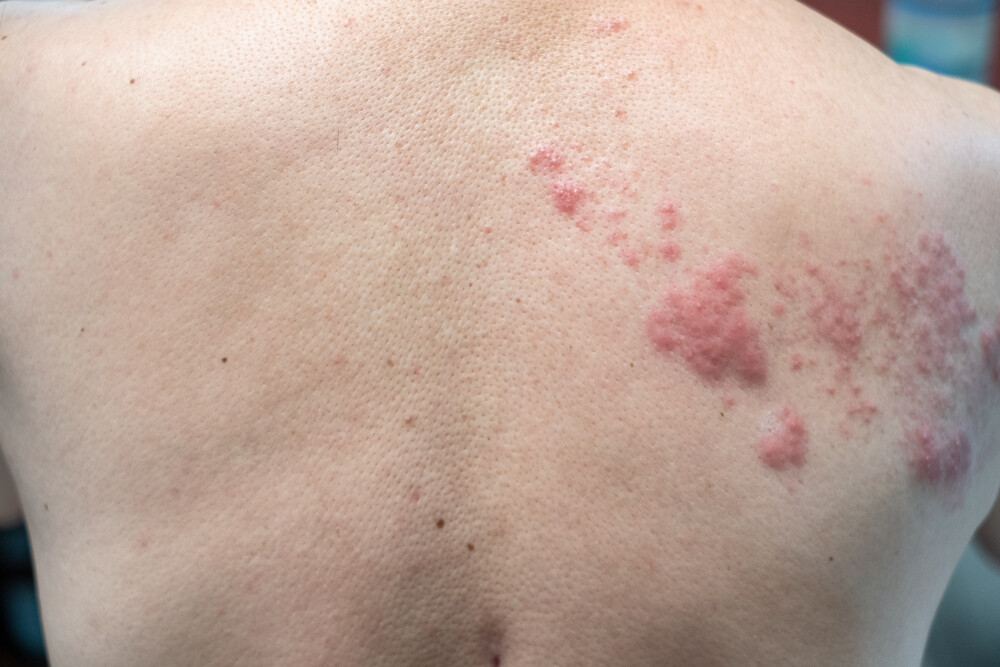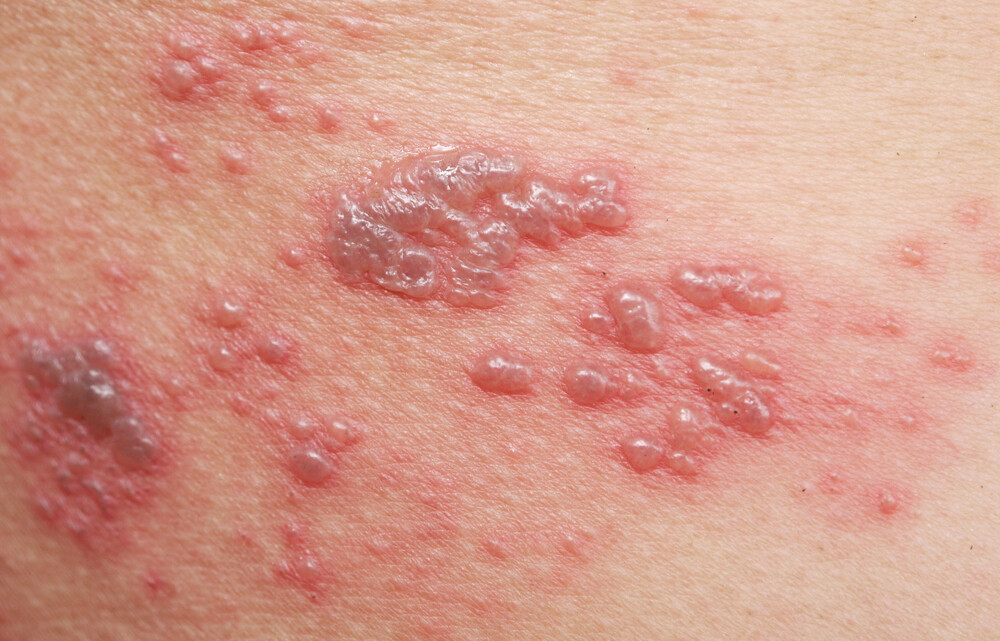Shingles is the second disease after chickenpox virus infection. Shingles usually occurs decades after infection with the virus. You can find all about shingles in our article…
Shingles: In brief
Typical of shingles is a belt-shaped skin rash consisting of redness and blisters, which can be very painful and can affect practically any part of the body. It is a reactivation of chickenpox viruses remaining in the body. The content of the blisters is contagious.
Shingles occurs mainly in the case of a weakened immune system and at an advanced age. Particularly in people under 50 years of age, the reasons for an outbreak should therefore be sought.
Early treatment is important to prevent permanent nerve pain, so-called post-zosteric neuralgia, or other complications. Drugs that inhibit the multiplication of the virus and painkillers are available for this purpose. Vaccination with inactivated vaccine is recommended for persons over 60 years of age, and for certain risk groups even from the age of 50.

What is shingles and what are the causes?
Shingles, also known as zoster or herpes zoster, is a hemiplegic, belt-like, strongly painful skin rash. The cause of shingles (herpes zoster) is an infection with the chickenpox virus (Varicella zoster virus). This virus belongs to the herpes virus family and can cause two different clinical pictures.
First of all, chickenpox (varicella) can develop, a disease that most people have already experienced as children before the introduction of the chickenpox vaccination. Once the chickenpox rash has disappeared, however, the virus is not yet: like other herpes viruses, it survives in the human organism for life and nests in the cranial nerves and the nerve roots of the spinal cord (spinal and cranial nerve ganglia).
Under certain circumstances, for example with increasing age and a weakened immune system, the viruses begin to multiply again, migrating along the nerve outwards to the skin. Shingles then occurs in the area supplied by the nerve into which the viruses had retreated. All parts of the body, the face and also organs such as the eyes or the brain can be affected.
The chickenpox virus occurs worldwide. Humans are the only known reservoir of Varicella zoster virus.
Infection
Chickenpox is very contagious and spreads quickly. The viruses are transmitted by droplet infection. This means that the droplets secreted during breathing or coughing are contagious. In addition, the pathogen can be transmitted through contact with the contents of the vesicles or crusts containing the virus (smear infection).
Is shingles contagious?
Yes, patients with shingles can also transmit the virus via a smear infection, even if they are not as contagious as a child with chickenpox, for example.
Risk factors for reactivation
The virus only becomes active again under certain circumstances. This is particularly the case in the case of a temporary or disease-related weakness of the immune system’s defences, as well as in old age, which also leads to a decrease in the immune system’s defensive functions. Trauma, stress, UV radiation and immunosuppressive drugs can also promote the occurrence of shingles. Occasionally, herpes zoster also occurs spontaneously in young, healthy people.

Symptoms of shingles
In the case of shingles, the symptoms occur locally. While chickenpox affects the entire body, the symptoms of shingles develop unilaterally only in the area of skin that is supplied by the affected cranial or spinal nerve. The first signs of the disease are usually fatigue, possibly a slight fever and burning pain in the corresponding skin area. Sometimes itching may also be added.
A few days after the onset of the pain, the typical skin symptoms develop on one side in a circumscribed skin area: Redness, blisters on a reddened background, which stand together in groups and sometimes in the form of rosettes and can be partially filled with blood. After a few days the blisters burst and become encrusted, sometimes leaving scars and discoloured or discoloured areas of skin (pigmentation or depigmentation). The full regression of the symptoms of shingles can take up to a month.
Complications
Although the varicella zoster virus primarily affects the nerves of the thoracic and lumbar spine and, in older people, often the nerves of the face, shingles can also affect regions other than the arms, legs, chest, stomach, back and head. In rare cases, serious forms of the disease occur. This happens especially when the cranial nerves are involved and for example herpes zoster of the eye (zoster ophthalmicus with eye infestation) or ear (zoster oticus) develops. If the cornea or the iris of the eye or especially the optic nerve is affected, permanent visual disturbances up to blindness can occur. Shingles in the area of the ear often leads to facial paralysis (facial nerve palsy). Such a paralysis of the facial muscles sometimes also develops with a herpes zoster infection in the neck area.
In cases of pronounced immune deficiency, shingles can also spread to the entire skin and internal organs (disseminated zoster) and cause life-threatening complications. In very rare cases, inflammation of the meninges and brain (meningitis and encephalitis) develops.
In children, shingles generally progresses harmlessly and without complications and almost always heals completely. In adults, the disease can cause severe pain due to acute nerve inflammation, which in some cases can become chronic and persist for months and years after the onset of shingles (post-zosteric neuralgia). The risk of developing post-zosteric neuralgia is particularly high in the case of shingles in the head region and increases with age.
Diagnosis
The drugs that inhibit the multiplication of the Varicella zoster virus work particularly well if they are administered early. Therefore, if shingles is suspected, a doctor – ideally a specialist in skin diseases – should not be hesitated for long, but should be consulted immediately. He or she can usually diagnose shingles on the basis of an interview with the affected person (anamnesis) and the typical symptoms.
In unclear cases, laboratory tests are necessary to reliably detect the Varicella zoster virus. With the help of a laboratory method such as the direct immunofluorescence test or the so-called PCR – polymerase chain reaction – the viruses or even minute amounts of the pathogen’s genetic material can be detected in vesicular fluid or cerebrospinal fluid (liquor).
If the eye or ear is suspected to be involved, it is advisable to consult an appropriate specialist (ophthalmologist or ear specialist) to prevent possible complications such as hearing or vision problems.
It is also important to clarify what led to the onset of the disease. If there are no obvious reasons, it may be worthwhile under certain circumstances to look for diseases that initially do not cause any symptoms of their own, but which nevertheless cause a weakened immune system, such as cancer or infection with the human immunodeficiency virus (HIV). HIV infection should be excluded in patients with herpes zoster who are younger than fifty years of age.
How can shingles be treated?
The symptoms of shingles can be alleviated with painkillers as well as drying and antiseptic solutions for application to the affected areas of the body. In addition, special drugs that inhibit the multiplication of the virus almost always have to be administered in tablet form or as an infusion through the vein.
These so-called virustatics, for example with the active ingredients Aciclovir, Famciclovir, Valaciclovir or Brivudin, ensure faster healing of the blisters and can reduce the risk of post-zosteric neuralgia.
Treatment with these drugs should preferably start within two to three days after the first symptoms appear. In patients who are younger than fifty years of age and only show very mild symptoms of shingles, for example in the chest area, antiviral therapy may also be unnecessary. In older patients with zoster in the head area (zoster ophthalmicus with eye infestation and zoster oticus), an antiviral therapy via the vein is always preferable, as strong pain can be quickly alleviated and complications prevented.
Early and adequate pain therapy is particularly important to prevent post-zosteric neuralgia from developing in the first place. If, however, persistent nerve pain does occur as a result of shingles, drugs such as pregabalin, gabapentin, carbamazepine, desipramine or amitriptyline, which are not painkillers in the true sense of the word, but belong to the group of antiepileptic drugs or antidepressants, can help. This does not mean that people who take these drugs are epileptics or depressive. It has been shown that post-zosteric neuralgia can be prevented and treated relatively well with these drugs.
Preventing shingles
Most people become infected with Varicella zoster viruses in their earliest childhood. The pathogens then remain in the body for the rest of their lives.
Shingles can also occur after a chickenpox vaccination, but this happens much less frequently than without immunisation. In addition, the disease is usually less severe in vaccinated persons. That is why the Standing Committee on Vaccination at the Robert Koch Institute (STIKO) has been recommending vaccination against chickenpox for all children since 2004.
In Germany, two approved vaccines against shingles are now available for persons over 50 years of age. This vaccination is carried out with the aim of suppressing a new outbreak of the varicella zoster virus and thus the disease shingles. In addition to the attenuated live vaccine approved several years ago, which is administered once under the skin, a further vaccine has been available since spring 2018, which is injected into the muscle in two doses. It is a dead vaccine, a so-called recombinant subunit vaccine. In contrast to the live vaccine, it can also be used to vaccinate patients with a weakened immune system.
The permanent vaccination commission of the medical profession (STIKO) recommends vaccination with the new inactivated vaccine for all persons over 60 years of age. People at particular risk of shingles due to a weakened immune system or other basic diseases should receive the vaccination as early as 50.
Important notice: This article contains only general information and must not be used for self-diagnosis or self-treatment. It cannot replace medical advice. Please understand that we cannot answer individual questions.

